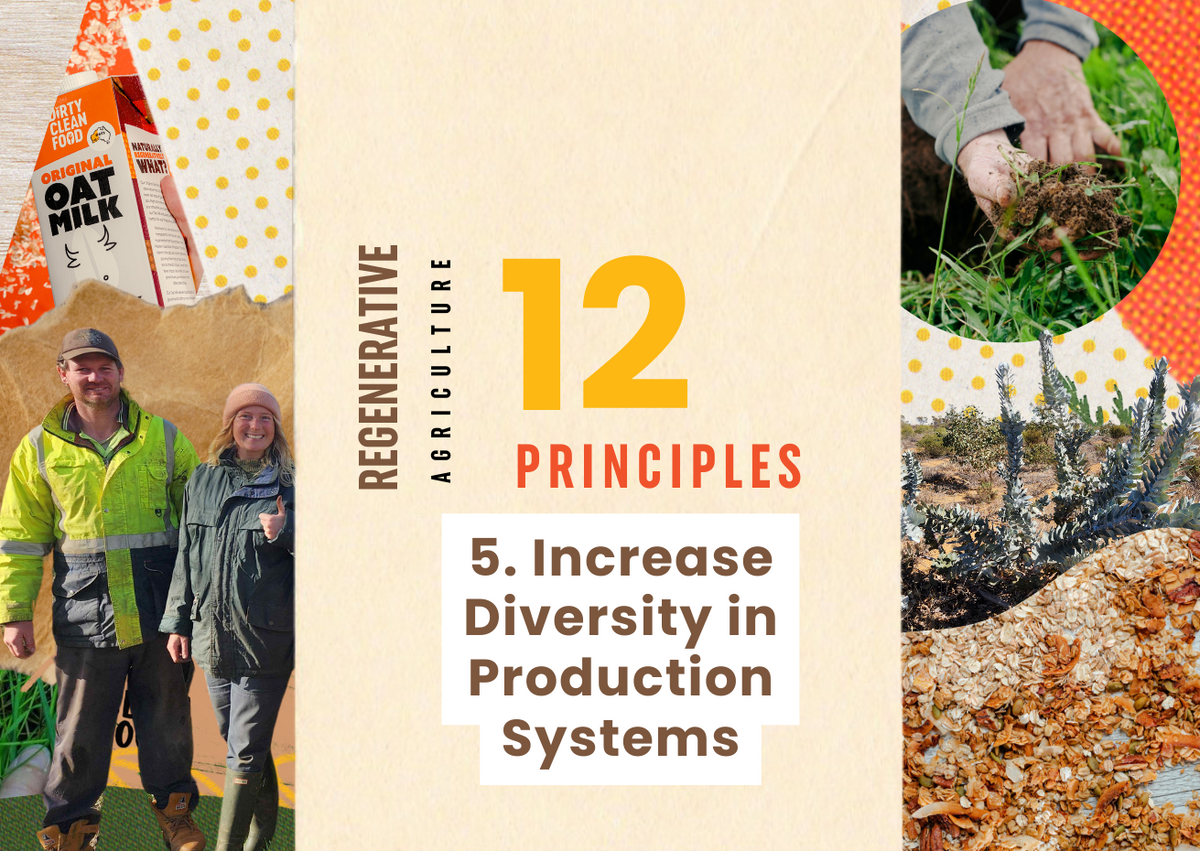
Regen Ag #5- Increase Diversity in Production Systems
|
Time to read 4 min
|
Time to read 4 min
Welcome to our 12 Principles of Regenerative Agriculture series- where we define "regen ag" and show you how regenerative farming changes the planet, the system, and our food.
In the ever-evolving landscape of regenerative agriculture, the principle of increasing diversity in production systems stands as a cornerstone of regenerative practices. This principle extends far beyond the simple act of growing multiple crops; it encompasses a holistic approach that integrates various elements to create thriving ecosystems. We have created a separate principle for multi species cropping, with this principle focusing on pollinator strips, biodiversity plantings, wind buffers, interplanting, and permanent plantings such as silvo pasture, all of which contribute to the vitality and resilience of agricultural landscapes.
Pollinator strips, often situated at paddock edges or interspersed within crop rows, serve as vital havens for bees, butterflies, and other pollinating insects. By planting diverse arrays of flowering plants, farmers provide essential forage for pollinators and enhance crop yields through increased pollination services. Moreover, pollinator strips contribute to the conservation of biodiversity, supporting a myriad of native plant and insect species. In WA, these are seen more in smaller scale vegetable growing areas.
Biodiversity plantings go hand in hand with pollinator strips, expanding the tapestry of plant life within agricultural landscapes. These plantings encompass a wide range of species, including native grasses, wildflowers, shrubs, and trees. By diversifying plant species, farmers create habitats for beneficial insects, birds, and other wildlife, fostering natural pest control and ecological balance. Additionally, biodiversity plantings can help mitigate soil erosion, improve water retention, and sequester carbon, further enhancing the resilience of the land. These areas can be both revegetation using endemic species, and or using exotic plants that seve a purpose within the surrounding ecosystem.
Wind buffers play a crucial role in protecting crops from wind erosion, temperature extremes, and moisture loss. Comprising dense rows of trees, shrubs, or grasses, wind buffers act as natural barriers, reducing wind velocity and creating microclimates that benefit crops and livestock. Moreover, these buffers serve as wildlife corridors, facilitating the movement of species across fragmented landscapes and promoting biodiversity conservation.
Interplanting, or companion planting, involves growing different crops together in the same field, either in alternating rows or mixed plantings. This practice not only maximizes land use efficiency but also enhances ecological interactions between plant species. For example, planting nitrogen-fixing legumes alongside nitrogen-demanding crops can reduce the need for synthetic fertilizers while improving soil fertility. Similarly, interplanting aromatic herbs or flowers can deter pests and attract beneficial insects, leading to healthier and more resilient agroecosystems.
Permanent plantings, such as silvopasture, integrating trees, shrubs, and perennial crops into agricultural systems, blurs the boundaries between forestry and farming. In silvopasture systems, livestock graze beneath the canopy of trees, benefiting from shade, forage, and shelter, while trees provide numerous ecological services, including carbon sequestration, soil stabilization, and wildlife habitat. By integrating trees and perennials into growing systems, farmers can enhance biodiversity, improve soil health, and diversify income streams, all while mitigating climate change.
Warren Pensini, Jamie Anderson, Stuart McAlpine, and our Goodies Farm friends of DCF farmers Dale and Penny Goodwin, are all using the Dirty Clean Food Regenerative Farmer Tree Project as a joint carbon project, as well as a biodiversity planting. With trees and shrub species chosen from their local area, they are re-introducing more flowering plants back into their farming systems, which will greatly benefit their whole farm system in the long run.
Stuart McAlpine has planted out a biodiversity planting with over 60 different species at his East kulinbah block. Dirty Clean Food planted these trees and shrubs back in 2019, and they are thriving! Stuart McAlpine has also planted saltbush as part of his perennial grazing at East Kulinbah, where saltbush will be grazed by his cattle as they are rotated over lupin and cropping stubble during the summer and autumn seasons.
Dale and Penny have included strips of trees as part of the carbon project to help mitigate the strong winds they get in winter down in Kendenup. These crops grown alongside these areas will benefit from a windbreak, as will the cattle they plant to rotationally graze through these paddocks.
Brad Campbell, our chickpea supplier, uses interplanting in his canola, planting an understory of lentils. The lentils fix nitrogen, which becomes available for the nitrogen hungry canola.
Jamie Anderson, one of our oats suppliers, has planted out some extensive areas of saltbush in some low saline areas that are no longer productive for cropping. These areas have some mature established flooded gums, that also like the low moist soil, with the saltbush forming more of an understory underneath these trees. Jamie will use these areas to help him bridge the autumn feed gap, producing feed for his sheep in the time before the first rains when sheep feed is becoming scarce.
Increasing diversity in production systems is not merely a goal but a guiding principle that underpins the transition towards regenerative agriculture. By embracing practices such as pollinator strips, biodiversity plantings, wind buffers, interplanting, and permanent plantings, farmers can cultivate resilience, restore ecosystem health, and foster vibrant rural communities. As we confront the challenges of a rapidly changing world, the path to resilient farming systems lies in embracing diversity and harnessing the power of nature to nourish both people and the planet.
‘Regenerative agriculture is an ecological approach to farming that allows landscapes to renew themselves.’









